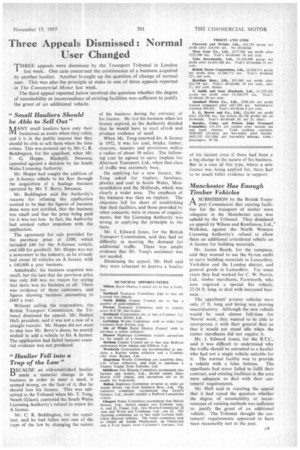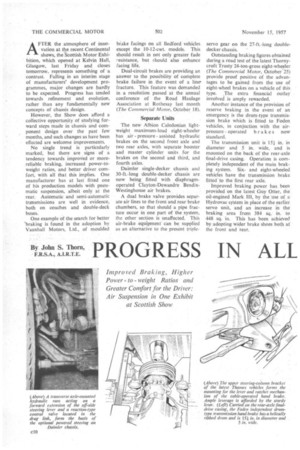Three Appeals Dismissed Normal User Changed
Page 45

Page 46

If you've noticed an error in this article please click here to report it so we can fix it.
THREE appeals were dismissed by the Transport Tribunal in London
last week. One case concerned the continuance of a business acquired by another haulier. Another brought up the question of change of normal user. This was also the principle at stake in one of three appeals reported in The Commercial Motor last week.
The third appeal reported below involved the question whether the degree of unsuitability or inconvenience of existing facilities was sufficient to justify the grant of an additional vehicle.
"Small Hauliers Should be Able to Sell Out"
ik ANY small hauliers have only their ILL businesses as assets when they retire, and it is in the public interest that they should be able to sell them when the time comes. This was .nointed out by Mr. C. R. Beddington, for the appellant, when Mr. F. G. Hoppe, Blackpill, Swansea, appealed against a decision by the South Wales Licensing Authority.
Mr. Hoppe had sought the addition of an A-licence vehicle to his fleet through the acquisition of a haulage business operated by Mr. T. Berry, Swansea.
Mr. Beddington said the Authority's reasons for refusing the application seemed to be that the figures of business done were not certified, that the business was small and that the price being paid for it was too low. In fact, the Authority had seemed rather impatient with the application_ The agreement for sale provided for the purchase price of £100, which included £40 for the A-licence vehicle, and £60 for goodwill. Mr. Hoppe was not a newcomer to the industry, as he already had about 10 vehicles on A licence, with a £40,000 a year business.
Admittedly, the business acquired was small, but the fact that the purchase price was only £60 was no reason for saying that there was no business at all. There was evidence of three customers, and figures showing business amounting to £665 a year.
Without calling the respondents. the British Transport Commission, the Tribunal dismissed the appeal. Mr. Hubert Hull, president, said it was not a case of a straight transfer. Mr. Hoppe did not want to step into Mr. Berry's shoes; he merely wished to add a vehicle to his A licence. The application had failed because essential evidence was not produced,
44 Haulier Fell into a Trap of the Law"
DECAUSE an old-established haulier
made a material change in his business in order to meet a need, it seemed wrong, on the face of it. that he should lose his licence. This was submitted to the Tribunal when Mr. T. Tong, Meath (Glam), contested the South Wales Licensing Authority's refusal to renew his A licence.
Mr. C. R. Beddington, for the appellant, said he had fallen into one of the traps of the Taw by changing the nature of his business during the currency of his licence. He lost his business when his Licence expired, as the Authority decided that he would have to start afresh and produce evidence of need.
When Mr. Tong renewed his A licence in 1952, it was for coal, bricks, timber, concrete, manure and provisions within a radius of about 50 miles. The following year he agreed to carry tinplate for Abernant Transport, Ltd., when that class of traffic was extremely busy.
On applying for a new licence. Mr. Tong asked for tinplate. furniture. plastics and coal' in South Wales, Monmouthshire and the Midlands, which was clearly a wider area. The emphasis of his business was then on tinplate. The objectors fell far short of establishing that their facilities, and those provided by other concerns, were excess of requirements, but the Licensing Authority was wrong in applying the principle to the facts.
Mr. L Edward Jones, for the British Transport Commission, said they had no difficulty in meeting the demand for additional traffic. There was ample evidence that Mr. Tong's assistance was not needed.
Dismissing the appeal, Mr. Hull said they were reluctant to deprive a haulier of his licence even if there had been a a big change in the nature of his business. But in a case qf this type, where a new licence was being applied for, there had to be much fuller evidence in support.
Manchester Has Enough Timber Vehicles
A SUBMISSION by the British Transin, port Commission that existing facilities for the transport of timber were adequate in the Manchester area was upheld by the Tribunal. They dismissed an appeal by Wilson and Rawlinson, Ltd.,' Walkden, against the North Western Licensing Authority's refusal to allow them an additional articulated vehicle on A licence for building materials.
Mr. James Booth, for the company, said they wanted to use the 44--ton outfit to carry building materials in Lancashire, Yorkshire and the London district, and general goods in Lancashire. For some years they had worked for C. W. Norris, Ltd., timber merchants, Farnworth, who now required a special flat vehicle, 22-24 ft. long, to deal with increased business.
The appellants' present vehicles were only 17 ft. long and hiring was proving unsatisfactory. Although the new vehicle would he used almost full-time for Norris' work, they wanted to be able to incorporate ii with their general fleet so that it would not stand idle when the timber merchants did not require it.
• Mr. J. Edward Jones, for the B.T.C., said it was difficult to understand why the traffic should he entrusted to a haulier who had not a single vehicle suitable for it. The normal facility was to provide a vehicle with a false bottom. The appellants had never failed to fulfil their contract, and existing facilities in the area were adequate to deal with their customers' requirements.
Mr. Hull said in rejecting the appeal that it had raised the question whether the degree of unsuitability or inconvenience of existing methods was sufficient to justify the grant of an additional vehicle. The Tribunal thought the customers' requirements appeared to have been reasonably met in the past. AFTER the atmosphere of innovation at the recent Continental shows, the Scottish Motor Exhibition, which opened at Kelvin Hall, Glasgow, last Friday and closes tomorrow, represents something of a contrast. Falling in an interim stage of manufacturers' development programmes, major changes are hardly to be expected. Progress has tended towards refinement and evolution, rather than any fundamentally new concepts of chassis design.
However, the Show does afford a collective opportunity of studying forward steps made in chassis and component design over the past few months, and such changes as have been effected are welcome improvements.
No single trend is particularly marked, but there are signs of a tendency towards improved or morereliable braking, increased power-toweight ratios, and better driver comfort, with all that this implies. One manufacturer has at last fitted one of his production models with pneumatic suspension, albeit only at the rear. Automatic and semi-automatic transmissions are well in evidence, both on coaches and double-deck buses. .
One example of the search for better 'braking is found in the adoption by Vauxhall Motors, Ltd., of moulded brake facings on all Bedford vehicles except the 10-12-cwt. models. This should result in not only greater fade resistance, but should also enhance facing life.
Dual-circuit brakes are providing an answer to the possibility of complete brake failure in the event of a line. fracture. This feature was demanded in a resolution passed at the annual conference of the Road Haulage Association at Rothesay last month (The Commercial Motor, October 18).
Separate Units The new Albion Caledonian lightweight maximum-load eight-wheeler has air pressure assisted hydraulic brakes on the second front axle and two rear axles, with separate booster and master cylinder units for the brakes on the second and third, and fourth axles.
Daimler single-decker chassis and 30-ft-long double-decker chassis are now being fitted with diaphragmoperated Clayton-Dewartdre BendixWestinghouse air brakes.
A dual brake valve provides separate air lines to the front and rear brake chambers, so that should a pipe fracture occur in one part of the system, the other section is unaffected. This air-brake equipment can be supplied as an alternative to the present triple
servo gear on the 27-ft.-long double decker chassis. '
Outstanding braking figures obtained during a road test of the latest Thornycroft Trusty 24-ton-gross eight-wheeler (The Commercial Motor, October 25) provide proof positive of the advantages to be gained from the use of eight-wheel brakes on a vehicle of this type. The extra financial outlay involved is amply rewarded.
Another instance of the provision of reserve braking in the event of an emergency is the drum-type transmission brake which is fitted to Foden vehicles, in conjuction with the airpressure operated brakes now standard.
The transmission unit is i51 in. in diameter and 5 in. wide, and is mounted on the back of the rear-axle final-drive casing. Operation is completely independent of the main braking system. Sixand eight-wheeled vehicles have the transmission brake fitted to the first rear axle.
Improved braking power has been provided on the latest Guy Otter, the oil-engined Mark Ill, by the use of a Hydrovac system in place of the earlier servo unit, and an increase in the braking area from 384 sq. in. to 448 sq. in. This has been achieved by adopting wider brake shoes both at the front and rear.








































































































